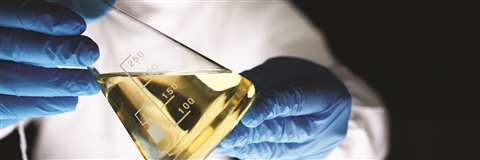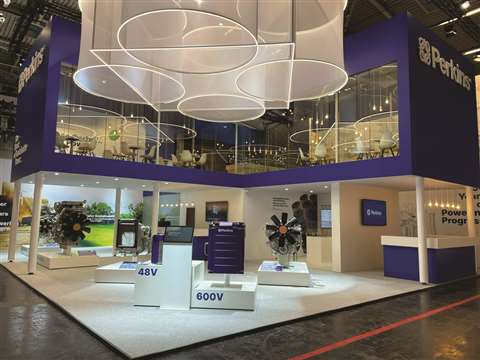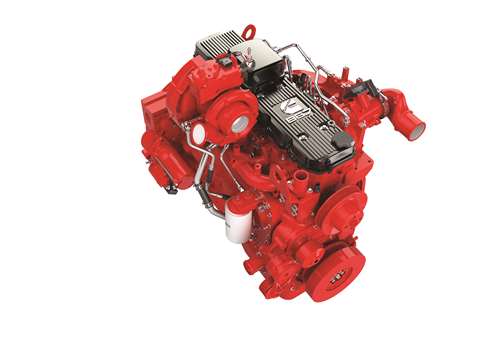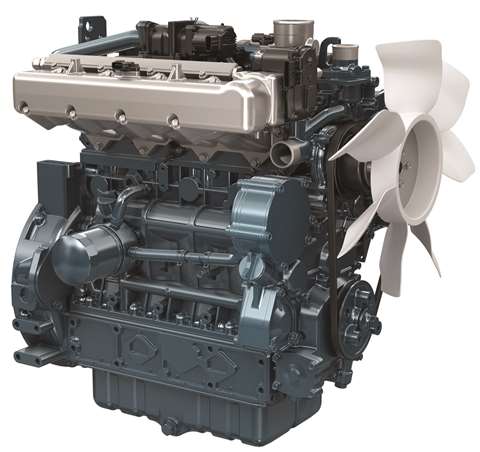Achieving peak efficiency in diesel technology
27 March 2023
Engine manufacturers have been steadily improving diesel technology, reducing emissions and also improving fuel economy, reports Julian Buckley.
Most construction companies are now looking at how they can reduce their CO2 footprints. There are a variety of routes to achieving that goal, with solutions tailored to a given business function. Across the front office, a culture of reduced energy usage can help cut power consumption. On work sites, switching over to equipment that uses low-CO2 energy can reduce harmful emissions and, often, cut noise pollution.

With the advent of market-ready electrified powertrains, gas-fuelled internal combustion and even fuel cell electric drives, where does the push for CO2 reductions leave diesel power? With the intense media focus on new tech, you might think that diesel engines will soon be appearing at a museum near you, where visitors can marvel at the historic technology that once supported the global construction industry.
While switching over to machines that use new power is good for public relations and the atmosphere, it comes at a price. Considerable capital investment is required to replace older machines with those using electric and gas fuel power. Such a move can also necessitate a change in work practises regarding operation and fuelling, possibly resulting in lost machine uptime and still more spend.
None of this is very appealing to companies already operating in a higher cost, lower margin environment. So, what’s the alternative? Well, while we were looking at bigger and better battery packs, diesel technology has made real improvements. With cleaner combustion cycles, the introduction of low-carbon fuels and advanced emissions treatment hardware, diesel has never been cleaner. So clean are the latest on-highway diesel engines that proposed Euro 7 standards have truck manufacturers focusing on reducing brake dust and tyre particulates rather than engine emissions.
Expertise from diesel manufacturers
Perkins Engines has produced about 22 million diesel engines since it was founded in 1932. From its first factory, located in Peterborough, UK, the company has expanded to a network of manufacturing locations in various countries around the world, including the US, China, Brazil and India.
The manufacturer offers a wide range of industrial engine sizes; manufacturing is generally split between small and medium (0.5 to 7.1 litres) and large engines (7.2 to 18 litres). Around the world, a Perkins engine comes off a production line every 15 seconds.
 Perkins stand at Bauma 2022
Perkins stand at Bauma 2022
At this year’s Bauma Munich, Perkins introduced its first battery packs for use in heavy machinery. But while today’s market requires OEMs to offer a full range of power solutions, the company remains a leading provider of diesel engines and developer of technologies intended to improve diesel engine performance.
Having been with Perkins for more than 20 years, Paul Muller, technical sales manager, is well placed to respond when asked about the benefits of modern diesel engines.
“Diesel is incredibly energy dense,” he explains. “It’s a very good way of moving energy from A to B. Batteries can be a challenge when it comes to getting the same energy density onto machines. The packs have to be able to do a day’s work, or there needs to be the recharging infrastructure.
“There are a number of applications which will be more difficult to move to alternative power sources; that doesn’t mean we won’t be able to do that in the future, but there are still some important applications where diesel just makes sense.”
Smaller, lighter machines are ideal for a swap to electric power, but Muller says that in cases where infrastructure is not available – particularly where infrastructure creation is the project at hand – it’s necessary to bring energy to that location and diesel has, and will continue to be, a great way to get energy to where it is needed.
“Compression ignition combustion engines are a pretty efficient way of turning one form of energy into another one. You can run lower-carbon fuels, hydrotreated vegetable oils (HVOs), synthetic diesels with increased levels of biofuel to reduce the carbon impact. But today’s diesel engines, particularly when looking at NOx and particulates, are incredibly clean compared to where they were.”
Muller puts forward that, since regulations were first put in place, the emissions levels of these pollutants from diesel engines has been cut by about 95%.
That’s not to say that Perkins is ignoring other solutions; the company is continuing to investigate power technologies as they emerge. Muller states that picking one over another is not beneficial, but all tech solutions can and will be made more efficient over time.
“We’re continuing to improve all our solutions at the same time, looking at the machines and the applications where they’re being used. Running up to 20% biofuel is acceptable with our current range of engines and we’ve found that running on synthetic diesel or HVO can make a big difference if they’re available. But the message about diesel engines is that if you’re concerned about your carbon, you can do something about it now.”
Diesel - is it the default choice?
Another major manufacturer of engines for the off-highway market is Cummins.
 Steve Nendick, marketing communications director, Cummins (Photo: Cummins)
Steve Nendick, marketing communications director, Cummins (Photo: Cummins)
Steve Nendick, marketing communications director for Global and European Off-Highway, Cummins, says that diesel engines will remain the default choice for the majority of machines due to its flexibility, coupled with the lack of infrastructure to support electricity delivery and hydrogen suppliers.
“A Cummins B6.7 can power machinery across a wide power band of 150 to 320hp,” he says. “A [machine] manufacturer can adapt a common, cost-effective installation across a range of power needs. For alternative power, due to the cost and size/space impact of the technology, it needs to be specific to exactly meet the duty cycle of the machine.”
He adds that the Cummins Performance Series range of Stage 5-compliant engines can already satisfy the duty cycles of various construction machinery demands, while generating near zero NOx and particulate emissions.
Engine downsizing is important to supporting those reductions. “The Performance Series can replace engines of higher displacement without impacting productivity,” adds Nendick. “It delivers a lower-cost installation and more efficient operation, with less fuel and lower CO2 emissions. Servicing costs are also reduced, with less oil and filters needed.”
Volvo Penta has introduced a series of machines using electric and gaseous fuel power, but the company
 The Cummins B6.7 Performance Series has replaced engines with larger displacement (Photo: Cummins)
The Cummins B6.7 Performance Series has replaced engines with larger displacement (Photo: Cummins)
remains a major manufacturer of diesel engines. As stated in its marketing material, low weight, low fuel consumption and dependable power still makes diesel ideally suited for numerous machine and equipment applications.
Morgan Blomgren, director of strategy and business development, Volvo Penta, says that the ubiquity of diesel across industrial applications has generated the need for improved efficiency and performance. But limited availability of ‘new’ fuel types and related infrastructure are also continuing to support compression combustion.
“The availability of diesel fuel is still, to an extent, the primary attraction; but some substantial legacy investments across certain industries and businesses could make it challenging to simply change out of existing systems,” he points out.
This is reflected in the number of ‘new power’ machines appearing on work sites. “So far, the shift to alternative fuel and electric power in the construction segment has been limited,” says Blomgren. “However, there are signs in markets like China, for example, that it’s picking up. So likely we’ll see a bigger change in coming years.”
Volvo Penta has pledged to achieve net-zero value chain emissions by 2040. Blomgren puts forward that this will be supported by wider changes in the construction sector. “Our electric drivelines for construction applications meet with stricter emissions and noise regulations in urbanised settings.”
High efficiency in diesel technology
In December 2022, China’s Weichai Group announced that it had achieved a brake thermal efficiency (BTE) rating of 52.28% for a commercial diesel engine. The findings were certified by the testing authority TÜV Nord. This was not the first record of its type for the company; in September 2020 Weichai revealed it had achieved a BTE rating of 50.23% and in January 2022, a figure of 51.09% was reached.
“There are a series of routes to reaching this efficiency level,” says Muller. “At Perkins, we’re looking at different oils to help reduce friction. Achieving a favourable balance between protection and lubrication is critical and diesel engine oils have advanced as the engines have been developed. We also look at the ring packs, and combustion, using advanced computational fluid dynamics to determine the most effective spray [injection] patterns and getting maximum energy out of minimum fuel.”
Beyond improvements across the engine, he notes that working with customers on integration projects helps to lift efficiency. Elements such as machine warm up to help reduce friction and improve fuel economy at start-up. The company is also revisiting hybridisation, together with the electrification of peripheral components to reduce load on the engine. “We’ve seen applications move from an engine-driven fan to an electrically-driven fan. We were still using the engine to produce the electricity, but the efficiency gains were really good,” says Muller.
Siobhan Scott, marketing manager at Perkins, adds that it will be investigation of separate areas across the engine that will deliver better efficiency. “There’s no one thing in a diesel engine which will change dramatically, deliver a big step change. It’s a case of looking at specific areas and together those individual wins will add up to big improvements.”
“We’re looking at ways to make every drop of diesel fuel count,” says Muller. “We think that diesel will be around for a while yet, so we’ll look to drive that efficiency up and up.”
Meeting engine regulations
 Paul Muller, technical sales manager at Perkins
Paul Muller, technical sales manager at Perkins
According to Muller, increased engine displacement does not return a proportional increase in emissions, with the exception of those engines produced for applications not required to meet specific targets. That said, he advises that the products that Perkins manufactures fall within the most regulated band of engines. “Regulations per kilowatt of a 500kW engine are the same as a 60kW engine.”
While displacement is not directly related to emissions, engine output is far more critical. “Over the years, we’ve pushed engine downsizing to increase power density,” he says. “Where a large engine will produce higher emissions is when you’re using too big of an engine for the application. We work with customers to really understand their application, studying the data to help them choose the right engine size and power. A right-sized engine running near the top of its capabilities will be a cleaner engine – a happier engine.”
Essentially, speed and load factor are critical to engine efficiency and reduced emissions. In these instances, an engine will be operating at the right temperatures, while coolant will have the correct flow rates. All of which adds up to an engine operating in its sweet spot.
“We used to see that a lot, an application where an 18-litre engine was used to deliver 100kW of power. We’ve had projects where we downsized from 13- to 7-litre engines. The turbochargers we use with our 4.4- and 7.1-litre engines, those have allowed us to replace larger, inefficient models with a version which is much more power dense and they end up being much cleaner.”
Torque delivery can also play a part in engine selection. The torque output curves of on- and off-highway engines can be dramatically different. Muller says that this is where an on-highway engine adapted for off-highway use can struggle. But as an off-highway engine specialist, the air, fuel and combustion systems used on Perkins engines help to deliver the required torque, while also reducing related emissions.
Together with optimised engine selection, cutting emissions is a case of continuous technology improvement. “We’ve made some incredible advances, but we’ll continue to push and find ways to reduce [diesel] emissions,” says Muller. “We’ll try and make the engines more efficient so they use less fuel and we’ll make them run on as many fuels as possible. The goal is to optimise, while we continue on the journey to reduce carbon.”
 David Kohler
David Kohler
The Kohler Board of Directors has elected President and Chief Executive Officer David Kohler to the additional role of Chair of the Board, following the passing of Executive Chairman Herbert V. Kohler, Jr.
David Kohler will Chair the Board of Directors and Executive Committee, in addition to his role as Chief Executive Officer, which will include full scope responsibility for the three business groups of Kohler Co. and all enterprise functions.
David has been with Kohler Co. for over 31 years and was elected to the role of President and CEO in 2015, having previously served as President and COO since 2009. He is the fourth generation of Kohler family leadership since the company’s inception in 1873, and only the ninth person to lead the company over the last 149 years.
 Kubota’s WG3800-H2 engine (Photo: Kubota)
Kubota’s WG3800-H2 engine (Photo: Kubota)
Powered by an industrial hydrogen engine pioneered by Kubota Corporation, Denyo has started the development of a hydrogen-fuelled generator.
As part of the company’s initiatives to produce carbon neutrality in its engines, Kubota has been researching engines for industrial machines that have greater fuel efficiency and which are able to use carbon-free fuels such as hydrogen, bio and synthetic.
The Kubota 3.8 L industrial off-highway hydrogen engine eliminates carbon dioxide emissions by using hydrogen.
The development is making progress within the high-volume sector of portable generators by Denyo by using a 45kVA diesel generator as a base and aims to release a dedicated hydrogen-fueled generator into the market early.
A fuel-cell portable generator produces electric energy through a chemical reaction between hydrogen and oxygen. A hydrogen mixed combustion generator uses technologies to limit carbon dioxide emissions through the combustion of hydrogen in combination with other fuels, such as diesel and city gas.
STAY CONNECTED



Receive the information you need when you need it through our world-leading magazines, newsletters and daily briefings.
CONNECT WITH THE TEAM








